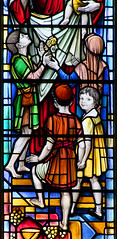 |
|
In 1812, a group
of like-minded Wesleyans formed a
congregation which met in Long Lane, and
in 1816 they built themselves Ebenezer
Wesleyan Chapel in Market Lane, both
these now-lost Ipswich thoroughfares
being in St Lawrence parish in the town
centre. At the time of the 1851 Census of
Religious Worship, the Market Lane chapel
was recorded as having 735 seats - that
is to say, it was a large building. The
minister, Ebenezer Moulton, recorded
about 300 worshippers present on the
morning of the census, and about the same
number in the afternoon. In 1860, the community
raised the money for a similar-sized
church but with the addition of parish
rooms and a school, to be built not far
off in Museum Street. The architect was
Frederick Barnes, who designed a number
churches in the Ipswich area, although he
is perhaps best known for the Great
Eastern Railway stations along the
Ipswich to Cambridge line. The community
became part of the newly combined
Methodist Church in 1932.
Pevsner thought it
good in itself, but incongruous in the
context of Museum Street. Welll, the
church does strike a rather jarring note
among the Georgian frontages, although I
think that the loggia entrance provides a
convincing moment of Victorian civic
optimism opposite the formal, guarded
frontage of the former museum, now
Arlington's restaurant. However, the
interior was turned around in the 1950s,
so that the entrance from Museum Street
is now along a side passage, which isn't
entirely satisfactory, and the new main
entrance on Black Horse Lane is viewed
across a car park.
From the new
entrance you walk along a corridor which
leads into the various parish rooms, and
then eventually through a small doorway
into the church beyond. With the gallery
above, it is hard to imagine that the
church was once the other way around.
|

